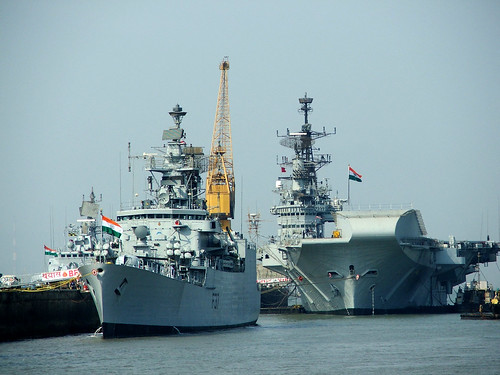
NEW DELHI – Winter is India’s diplomatic high season, with the cool, sunny weather forming an ideal backdrop for pageantry, photo ops at the Taj Mahal or Delhi’s Red Fort, and bilateral deal-making. But this winter has been particularly impressive, with leaders from Japan and South Korea visiting to advance the cause of security cooperation in Asia.
The first to arrive was South Korean President Park Geun-hye. Despite a strong economic foundation, the bilateral relationship has long lacked a meaningful security dimension. But China’s recent assertiveness – including its unilateral declaration last November of a new Air Defense Identification Zone, which overlaps about 3,000 square kilometers of South Korea’s own ADIZ, in the Sea of Japan – has encouraged Park to shore up her country’s security ties with India.
North Korean leader Kim Jong-un’s unpredictable and often provocative policies represent an additional impetus for improved ties – as do China’s increasingly visible plans to weaken South Korea’s alliance with the United States. Not surprisingly, the discussions during Park’s four-day visit focused on grand strategy, and included detailed talks on maritime security and naval shipbuilding.
Nuclear energy also featured prominently on the agenda, owing to both countries’ dependence on energy imported through dangerous sea-lanes. In 2008, South Korea, as a member of the Nuclear Suppliers Group, supported the waiver granting India access to civilian nuclear technology and fuel from other countries – both of which it had been denied since becoming a nuclear-weapons power in 1974. Indeed, India’s nuclear tests are what initially spurred the NSG’s formation. South Korea’s support of India’s civilian nuclear ambitions earned it high praise in India and helped to advance bilateral civilian nuclear cooperation.
This budding strategic partnership is undoubtedly important. But when it comes to the regional balance of power, India’s deepening ties with Japan are even more consequential.
While India’s relationship with the United States has been faltering of late, following the arrest and mistreatment of an Indian consular official in New York, its ties with Japan are flourishing. The visit last December of Japanese Emperor Akihito and Empress Michiko was the clearest sign yet of a de facto alliance between the two democracies.
The imperial couple last visited India more than a half-century ago, as Crown Prince and Princess, when India was part of the non-aligned movement and Japan was happy with a security guarantee from the US. But, with China’s rise having shifted Asia’s balance of power, Indian and Japanese leaders have been seeking new security assurances, and the visit by the Emperor and Empress was the clearest signal Japan could send concerning the value it places on this
emerging alliance.
The search for greater security was even more explicit in January, when Japanese Defense Minister Itsunori Onodera spent four days in India discussing the specifics of enhanced defense cooperation. During the meeting, Onodera and his Indian counterpartaffirmed their countries’ intention to “strengthen the Strategic and Global Partnership between Japan and India,” including “measures ranging from regular joint-combat exercises and military exchanges to cooperation in anti-piracy, maritime security, and counter-terrorism.” In fact, later this year, bilateral naval exercises will be held in Japanese waters for the first time – sending a powerful signal to China.
But Indo-Japanese relations must extend beyond the realm of security – something that Prime Minister Shinzo Abe, who has pursued enhanced bilateral ties more vigorously than any other Japanese leader, seems to grasp. Convinced that a strong India is in Japan’s best interests, and vice versa, Abe hopes to create a new “arc of freedom and prosperity” connecting Asia’s two major democratic economies.
While Abe could have done more during his recent visit to India to advance this vision for example, by meeting with Indian opposition leader Narendra Modi, who may become the country’s next prime minister – it seems certain that such a
relationship will be achieved in the coming years. Japan has already surpassed the US as one of India’s largest sources of foreign direct investment, accounting for inflows totaling $2.2 billion last year. And the two countries recently tripled their US dollar currency-swap arrangement, bringing it to $50 billion.
Abe, India’s chief guest at this year’s Republic Day celebrations, also rightly views enhanced trade as a key element in deepening the bilateral relationship, thereby contributing to substantially increased security. But bilateral trade amounted to only$18.4 billion in 2011-2012 – far smaller thanIndia-China trade and a pittance compared to Japan-China trade.
Even with a significant deepening of ties, however, bilateral relationships alone will be inadequate to counterbalance China. Achieving an internal Asian balance of power will require India, Japan, and South Korea to build a tripartite security arrangement, which can be achieved only if Japanese and South Korean leaders overcome their historical animosities.
As Winston Churchill declared in his famous 1946 speech in Zurich, “We cannot afford to drag forward across the years that are to come the hatreds and revenges which have sprung from the injuries of the past.” Just as France and Germany
pursued reconciliation in order to build a better future in the years following Churchill’s declaration, Japan and South Korea must learn to tame the hatreds and injuries of the past in order to build, with India, a structure of peace and a more prosperous future for Asia.
Copyright Project Syndicate
Jaswant Singh, a former Indian finance minister, foreign minister, and defense minister, is the author of Jinnah: India – Partition – Independence and India At Risk: Mistakes, Misconceptions And Misadventures Of Security Policy.
For additional reading on this topic please see:
Abe’s Visit to India: The Strategic Implications
Challenging Times in Indo-US Ties
India and the Changing Asian Balance
For more information on issues and events that shape our world please visit the ISN’s Weekly Dossiers and Security Watch.

